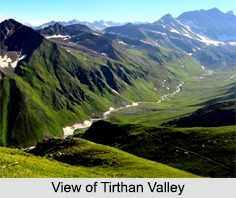 Tirthan Valley is located in the Kullu District</b> of Himachal Pradesh with an elevation of 1600 meters above mean sea level. The valley has derived its name from the Tirthan River, which flows through it. Tirthan River originates from Hanskund, the peak in the Great Himalayan National Park. Tirthan Valley is a gateway to the Great Himalayan National Park.
Tirthan Valley is located in the Kullu District</b> of Himachal Pradesh with an elevation of 1600 meters above mean sea level. The valley has derived its name from the Tirthan River, which flows through it. Tirthan River originates from Hanskund, the peak in the Great Himalayan National Park. Tirthan Valley is a gateway to the Great Himalayan National Park.
Visiting Places of Tirthan Valley
Chehni Kothi, Shringa Rishi Temple, serene waterfalls, Parashar Lake, Serolsar Lake are the popular places of Tirthan Valley, which visitors flock to every year. Some of the places are detailed below:
Serolsar Lake: Serolsar Lake is a 6 km trek from the Jalori Pass, which is popular for its astounding views. The lake is located amidst pine forest. There is a nearby temple, which is dedicated to goddess Buddhi Nagin, the mother of the 60 Nag Devtas of Himachali folklore. Goddess Buddhi Nagin is believed to reside in the lake.
Chehni Kothi: Chehni Kothi or Dhadhia Kothi is a 1,500 year old castle, which was built with stone slabs and wooden beams. It was once the residence of Rana Dhadhia, the erstwhile king of Kullu. It used to be 15 storeys high but after the earthquake of 1905, only 10 floors remain now. Built in traditional style of architecture, it is the tallest free-standing structure in the entire Western Himalayan region.
Parashar Lake: Parashar Lake is another popular visiting place near the valley. There is a three storey pagoda situated on the shores of the lake, which was constructed by King Bansen in 14th century. The temple and the lake were dedicated to Rishi Parashar, who meditated here.
Visiting Information to Tirthan Valley
Kullu-Manali Airport and Jogindernagar railway station are the nearest mediums to reach the place.
This article is a stub. You can enrich by adding more information to it. Send your Write Up to content@indianetzone.com



















